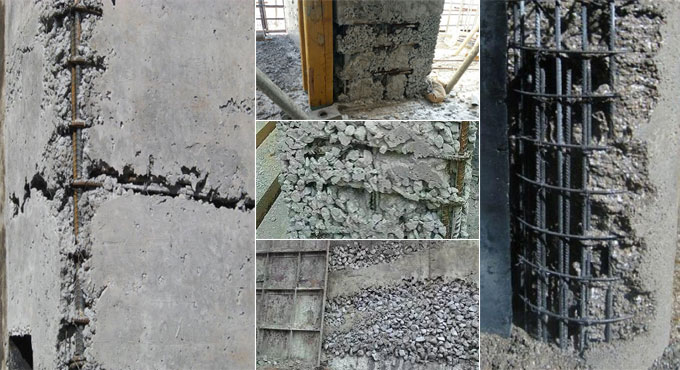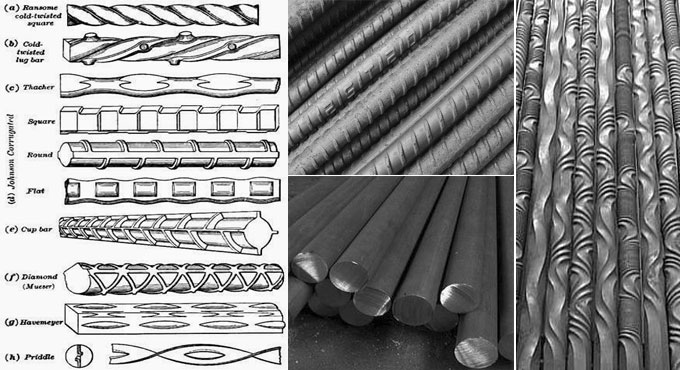Honeycombing refers to a structural defect related to a RCC Structure. The areas of the concrete surface where the coarse aggregate are clearly shown known as honeycombed surface that provides an appearance of honey bees nest.
If honeycombed surface is ignored, the RCC structure fails to function properly according to the design (structurally fragile). Besides, it enables penetration of damaging agents like impure water and air through the existing voids which impact the stability of the structure considerably.
Honeycombing happens for the following reasons :-
1. Concrete mix does not remain integral.
2. Existence of more percentage of larger size of aggregate in concrete resists concrete to fill narrow spaces among the reinforcement rods.
3. The workability of concrete is inadequate.
4. Inadequate compaction to concrete.
5. Imperfect vibration throughout concreting.
6. Steel congestion does not permit concrete to flow toward all corner.
7. Concrete is already set prior to placing.
8. High free fall of concrete at the time of pouring
9. Form work is not water-resistant or inflexible.
10. Inappropriate detailing and/or fixing of steel
11. Inferior proportion of cement to water that can minimize the workability of concrete.
Guidelines to get rid of Honeycombing in Concrete.
All concrete batches should be integrated; examine the concrete production/cohesiveness frequently. If it is possible to develop “ball” form the fresh concrete, concrete mix is defined as cohesive.
Concrete workability should meet the placement requirement, as for instance, a lightly reinforced column can contain 75mm slump, 150 mm slump is necessary for a highly reinforced column.
Make sure that exact compaction is provided for placed concrete, vibrators should be detached since large air bubbles stop to step out (over vibration will cause bleeding). The sizes of the vibrator needle should remain as 25 mm, 40 mm and 60 mm according to RCC sections.
Concrete should be exhaustively consolidated and fully functional around the reinforcement, around implanted fixtures as well as the corners of the formwork. Precautions should be taken throughout vibration otherwise honey combing may occur.
The strength of concrete is decreased by 30% due to 5% voids in concrete.
Cover to formwork, Pins and spaces bars to layers of reinforcement should be provided to maintain exact compaction.
Concrete should maintain Slump prior to placing. Besides, initial slump, concrete should be designed to detain slump untill the time it is set.
The height from where the concrete is dropped should be minimum, if possible concrete bucket with canvas pipes, concrete hose pipe, should be provided to minimize the concrete free fall height.
Formwork should be water resistant; cement grout should not be wasted at the time of placing concrete.
Steel detailing and fixing should be provided to allow smooth flow of concrete across all corners and depths. To get rid of steel congestion, special concrete formulations like self-compacting concrete, concrete with lower maximum aggregate size (12.5mm) etc should be used.
Read more

~~~~~~~~~~~~~~~~~~~~~~~~
Published By
Rajib Dey
www.constructioncost.co
~~~~~~~~~~~~~~~~~~~~~~~~
If honeycombed surface is ignored, the RCC structure fails to function properly according to the design (structurally fragile). Besides, it enables penetration of damaging agents like impure water and air through the existing voids which impact the stability of the structure considerably.
Honeycombing happens for the following reasons :-
1. Concrete mix does not remain integral.
2. Existence of more percentage of larger size of aggregate in concrete resists concrete to fill narrow spaces among the reinforcement rods.
3. The workability of concrete is inadequate.
4. Inadequate compaction to concrete.
5. Imperfect vibration throughout concreting.
6. Steel congestion does not permit concrete to flow toward all corner.
7. Concrete is already set prior to placing.
8. High free fall of concrete at the time of pouring
9. Form work is not water-resistant or inflexible.
10. Inappropriate detailing and/or fixing of steel
11. Inferior proportion of cement to water that can minimize the workability of concrete.
Guidelines to get rid of Honeycombing in Concrete.
All concrete batches should be integrated; examine the concrete production/cohesiveness frequently. If it is possible to develop “ball” form the fresh concrete, concrete mix is defined as cohesive.
Make sure that exact compaction is provided for placed concrete, vibrators should be detached since large air bubbles stop to step out (over vibration will cause bleeding). The sizes of the vibrator needle should remain as 25 mm, 40 mm and 60 mm according to RCC sections.
Concrete should be exhaustively consolidated and fully functional around the reinforcement, around implanted fixtures as well as the corners of the formwork. Precautions should be taken throughout vibration otherwise honey combing may occur.
The strength of concrete is decreased by 30% due to 5% voids in concrete.
Cover to formwork, Pins and spaces bars to layers of reinforcement should be provided to maintain exact compaction.
Concrete should maintain Slump prior to placing. Besides, initial slump, concrete should be designed to detain slump untill the time it is set.
The height from where the concrete is dropped should be minimum, if possible concrete bucket with canvas pipes, concrete hose pipe, should be provided to minimize the concrete free fall height.
Formwork should be water resistant; cement grout should not be wasted at the time of placing concrete.
Steel detailing and fixing should be provided to allow smooth flow of concrete across all corners and depths. To get rid of steel congestion, special concrete formulations like self-compacting concrete, concrete with lower maximum aggregate size (12.5mm) etc should be used.
Read more

~~~~~~~~~~~~~~~~~~~~~~~~
Published By
Rajib Dey
www.constructioncost.co
~~~~~~~~~~~~~~~~~~~~~~~~
